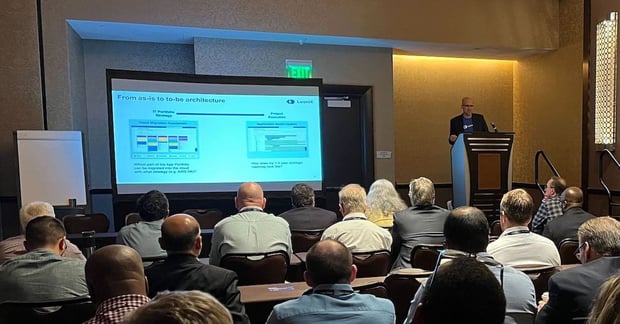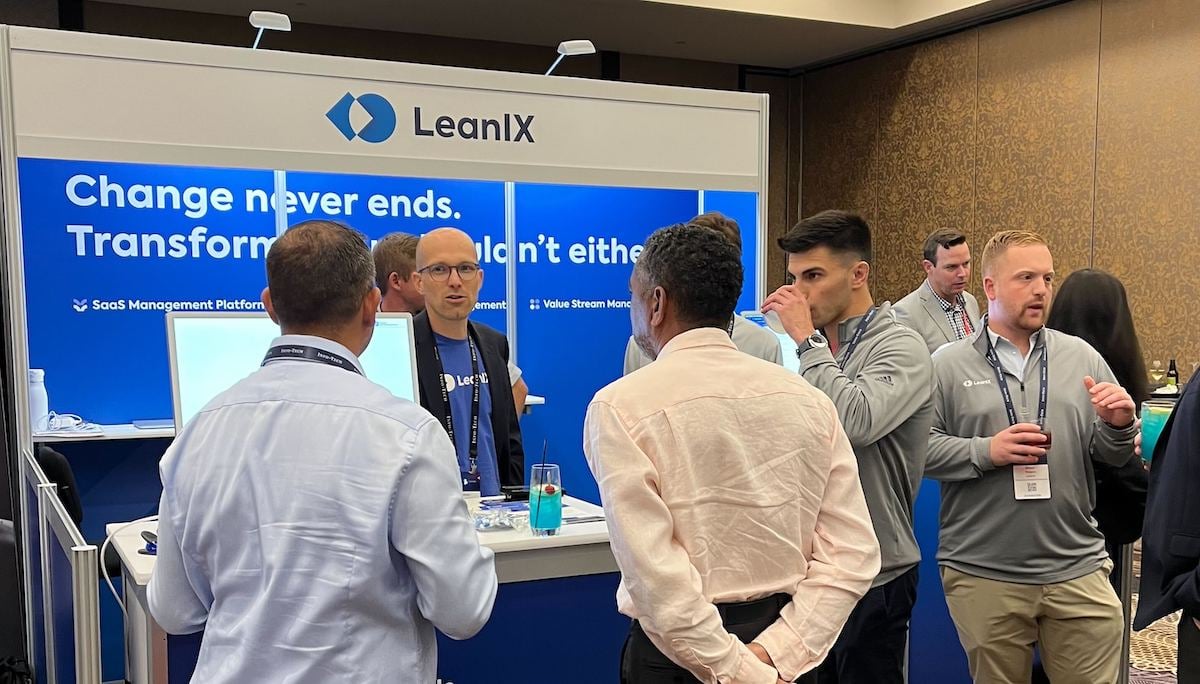
Cloud transformation and application modernization are becoming essential for organizations in the modern market. To complete this business transformation, our own Patrick Schober explains, you need a data-driven approach.
On September 20, 2023, LeanIX VP of Professional Services, Patrick Schober, presented a keynote on taking a data-driven approach to cloud transformation. His well-received presentation covered the full capabilities of the LeanIX platform to support application modernization across your IT landscape.
To find out more about using data to empower a cloud transformation, download Gartner's report on choosing the right approach:
GARTNER® REPORT: How To Choose The Right Approach For Application Modernization And Cloud Migration
Let's cover what Patrick explained during his presentation and how the LeanIX platform can support your application modernization initiative.
The Need For Cloud Transformation

Cloud transformation is becoming more than just a nice-to-have. The pandemic forced organizations to move to remote working and cloud solutions almost overnight, and many companies are still trying to complete that transformation, while managing the technical debt they acquired at its rapid-paced start.
Patrick explained that around 15,000 SAP enterprise resource planning (ERP) platform customers are still using the on-premise ERP Central Component (ECC) version of the tool. ECC is due to be retired in 2027, leaving many with a deadline to upgrade to the cloud-based SAP S/4HANA version.
Elsewhere, Patrick continued, Volkswagen CEO, Herbert Diess believes that 90% of automobile innovation will be software-based going forward. This means automobile manufacturers will rapidly need to adapt to become software companies, as well, and this change is being reflected in other industries too.
Even as enterprise struggles with these challenges, the world has changed once again. Patrick highlighted how generative artificial intelligence (AI) is rapidly changing the way we do business and leveraging this technology requires a modern application landscape.
Whether it's upgrading from on-premise to the cloud, refocusing on software, or pursuing an AI transformation, there's one thing that enables all these transformations, according to Patrick: simplicity.
Cloud Transformation Is A Battle For Simplicity
Application modernization is primarily the process of removing complexity from your IT landscape, often to enable cloud transformation. Complexity, however, is often hidden.
While your IT landscape may appear straightforward, there is often a great deal of hidden complexity behind the scenes. Think of it like an iceberg with only the peek showing above the water.
In addition, complexity is often complex in itself, and comes in a variety of flavors:
Functional complexity is where you have a monolithic tech stack that lacks agility or adaptability. To fight this, you need to break down your business capabilities into micro-services that can be easily replaced and pivoted.
Interface complexity is where an attempt has been made to adapt a monolithic stack to different user needs through application programming interfaces (APIs). This is ultimately more challenging than changing your monolith, due to the expense and challenges with integration testing.
Data complexity is where your data is disorganized, unformatted, dispersed across different systems, and lacking any ownership. Taking this 'data lake' of free-flowing information and organizing it into a 'data warehouse' that any application can access is key for enabling application modernization.
Technical complexity is where you have so many specialized systems that can only be operated by technical experts that no-one has a high-level picture of your software vulnerabilities and risk. Adapting to a simpler, user-friendly application portfolio gives a clear overview of your IT landscape to both your organization and to regulators.
Removing complexity from your IT landscape is rather like creating a garden. Before you can begin removing the weeds and planting new seeds, you need to know what space you have.
The key, therefore, to successfully simplifying your IT landscape is to gain clarity on your current state. Only then can you map out a plan to remove complexity from your architecture.
It's this kind of transparency that you can gain from an enterprise architecture management tool like the LeanIX platform. Let's look more closely at how you can put LeanIX into action.
4 Steps To Cloud Transformation
Armed with the transparency LeanIX can offer on your IT landscape, you'll be ready to enact an intelligent cloud transformation. Once you have that, Patrick listed the four steps you need to take to prepare for your initiative.
1 Cloud Strategy Review
Refine your cloud readiness criteria, including the scope of the portfolio assessment and common strategies for completion. Ensure you gain buy-in from your stakeholders and configure your LeanIX Factsheets ready for your initiative.
2 Portfolio Assessment
Once you have your cloud-readiness criteria, you can run pilot pre-tests for your key applications and develop a business case for them. Use LeanIX to launch a survey of your stakeholders and experts to complete your intelligence-gathering.
3 Results Verification
Deep dive into those LeanIX survey results and the LeanIX platform will automatically recommend any quick wins with 85% accuracy! Then it's time to choose your preferred approach and prepare a migration matrix of application complexity against migration urgency.
4 Road Map To Migration
Now, you can build your cloud migration road map within LeanIX, using all the established Factsheets and information you've prepared. Once that's complete, you're ready to get started.
5 Cloud Transformation Success Factors
70% of cloud transformations fail, according to the Boston Consulting Group, so ensuring rapid time-to-value is vital. In his talk, Patrick next explained the five key metrics that you need to focus on.
1 The Right Data
You can't know whether you've made the right decisions on cloud transformation unless you have the right key performance indicators (KPIs). Remember to embrace small data, looking to cover the whole of your organization, rather than deep dive into specific areas, to get a sense of how your transformation has supported your organization as a whole.
2 The Right Integrations
Remember to not just catalog your architecture, but where it links into your key third-party integrations, so you can ensure these have been maintained. LeanIX connects to a variety of key services to gather information on these integrations.
3 Product Not Project
Transformations never end, so don't think of your process as just a one-off project, but a new business capability working to continually optimize your application portfolio. A successful cloud migration will preserve all your working and data to enable the next transformation.
4 Business Alignment
Remember why you were transforming in the first place. If your cloud transformation hasn't re-aligned your IT landscape to your business strategy, then it's gone in the wrong direction.
5 Stakeholder Engagement
Just as you need the support of your stakeholders to succeed in cloud transformation, they are also the ones that can tell you whether it succeeded. If your stakeholders are thrilled with your new IT landscape, then you've done a good job.
Make Cloud Transformation Fast, Not Furious
One-off cloud transformation and application modernization projects take too long, cost too much, and rarely stick the landing. LeanIX enables data-driven, collaborative, and repeatable business transformations.
Give yourself the clarity you need to drive a successful cloud transformation, and gain the agility you need to adapt to the future. To find out more about LeanIX, book a demo:



